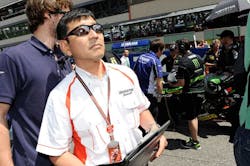By Neal Weingart
Yamada-san answers questions about MotoGP's evolution into a single tire supplier series and discusses his best experiences in MotoGP.
After an intensive tire war, Bridgestone entered 2009 as the new Official Tire Supplier to the MotoGP series. How did this affect the design philosophy of race tire construction for Bridgestone? And also, how did the relationships between Bridgestone and the teams change, particularly with regard to building race bikes to maximize use of the spec tires?
We've always had very good relationships with the teams we have worked with and in 2009 this didn't change. The manufacturers we worked with in the past during the tire competition era realized that the days of making bespoke tires for each rider were over, but they knew that we would continue to provide 100% commitment to supporting each and every team. Also, in 2008 we already supported bikes from each manufacturer so had enough data and experience to develop a range of tires that suited everyone. Also, while our previous focus had been mainly around outright performance and beating our competition, as sole tire supplier we could focus more on making tires with greater control and feel to improve rider safety. This was a very important shift in our focus and as a result, the sole tire supplier era has perhaps been of more benefit in terms of transfer technology to road tires than the competition era.
2015 has seen the introduction of an expanded range of compounds at each race. How instrumental was Dorna's role in this, and with the success this has brought this season, with many new lap and race records, do you wish Bridgestone had done this earlier?
As always, the revision to our tire allocation this year came after listening to the riders' comments and analyzing our data. Dorna aren't directly involved in helping us decide our tire allocation. We do at times work together with Dorna and the FIM in terms of defining regulations or in the case of the CRT and now open-class bikes, arranging in delivering softer compound tires for certain classes of machinery, but we are 100% responsible for deciding which compound allocation we bring to each circuit.
Our primary development focus is improving rider safety, by providing riders with better warm-up performance, control and feel, yet over the last few seasons we have also achieved many lap records. In 2014 we had a total of ten new race lap records and nine qualifying lap records — so every year tire performance is improving even though our main focus is better rider safety. Therefore I am happy with how our tire development has progressed during our time as Official Tire Supplier to MotoGP and think we have got a very good balance between safety, performance and durability.
In MotoGP the Bridgestone tires are provided for free to all competitors. Has this expense been a large influence on Bridgestone's decision to leave the MotoGP series at the end of this season?
The reason we have decided to leave MotoGP after fourteen seasons is simply down to the fact that we achieved all the goals we set out for ourselves when we started the project in 2001. As well as increased awareness of our brand, through winning many races and consecutive world championships in the tire competition era, and then becoming the first sole tire supplier to the series, we established ourselves as the technical leader in motorcycle tire development.
One last question Yamada-san, what has been the most satisfying experience for you during Bridgestone's participation in MotoGP racing?
I would have to say the feeling I had at Motegi in 2007 when we not only won our home race in Japan with Loris Capirossi on a Ducati, but Casey Stoner also won our first world championship was truly special. This was the day when Bridgestone showed the world that we were the leading tire manufacturer in MotoGP and the realisation of the goal we set out for ourselves just 6 years earlier.
However, if I have to choose the most satisfying experience during my time in MotoGP, it has been all the relationships our company has formed with the manufacturers, teams and riders over the past fourteen years in MotoGP. We have worked together in a way that has not only made MotoGP safer, but also more competitive and spectacular for the fans. I am proud that in our final year in the series, that MotoGP is in its strongest ever position with a record number of riders on the grid and record crowds flocking to watch the action.
Yamada-san is in the paddock at Mugello this weekend directing Bridgestone's efforts in rider safety and creating more memorable experiences. MTD Racing News thanks him for taking the time to talk with us and share his thoughts on the role Bridgestone has played in the MotoGP World Championship.
To read Part 1, click here.



